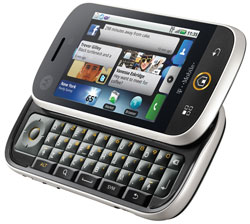
When Motorola announced its Android-powered Cliq late last week, it took what many view as a critical step toward regaining its former prominence in the mobile phone arena.
“Motorola was the No. 1 handset maker in the 1990s — they lost that position to Nokia and have been trying to recapture the market ever since,” telecom analyst Jeff Kagan told LinuxInsider. “They did well with the Razr a few years ago, but never had anything else to follow up.”
Over the past several years, Motorola fell to No. 3 and then No. 4 in the market.
“Could Cliq be the next Razr? Maybe — if it is great,” said Kagan.
“I think Motorola still has a strong brand name and can recover quickly if they can come up with a series of hits. If this Cliq is a hit, it will be a great first step,” he added.
Tit for Tat?
As much as the Linux-based Android platform has to offer Motorola, however, there’s at least the potential for Motorola to give a reciprocal boost to Android as well.
The platform, first announced nearly two years ago, has taken some time gaining momentum in the form of hardware and carrier support. However, as the fourth quarter approaches — along with the holiday shopping season — the announcements are beginning to roll out.
On Monday, for example, LG — the industry’s third-largest player — announced the LG-GW620, its first Android-powered phone, complete with a 3-inch full touchscreen and slide out Qwerty keypad.
Meanwhile, HTC unveiled its Tattoo device last week, while earlier this month Sprint joined T-Mobile as a supporting carrier.
‘Important for Android’
Indeed, it is on support from both handset makers and carriers that many Android hopes ride, in terms of its ability to do battle with Apple’s wildly successful iPhone.
Motorola’s phone “will be important for Android,” Kagan said. “If successful, it will punch Android onto the map.”
It could help the platform, In-Stat principal analyst Allen Nogee agreed.
‘A Good Sign’
“Motorola phones are quite popular in the U.S. and Asia,” Nogee told LinuxInsider, “and Motorola was at one time quite big in China.”
Many Americans, in fact, support Motorola for being “more of an American company” than many others, he added.
Android will likely claim an increasing proportion of the market in the next five years, according to In-Stat.
“Overall, I think seeing more and more manufacturers go to Android is a good sign,” Nogee said.
An Army of Individuals
Where there is just one iPhone and just one supporting carrier, Android will have what many call an “army” of handsets for consumers to choose from, each with its own distinguishing spin on the platform.
“What each handset vendor wants you to walk away with is, yes, you have an Android handset, but you also have their own take on it,” Ramon Llamas, a senior research analyst with IDC, told LinuxInsider.
The competing Windows Mobile platform, by contrast, is “pretty much the same across different companies’ handsets,” he noted.
All About Distribution
So, while Android is undoubtedly a significant part of Motorola’s hoped-for recovery, Motorola’s support is just one piece of what Android will need to be successful.
“If you’re a developer, you want to get your apps out onto as many devices as you can,” Llamas explained. “We’re still in the very initial phases now when it comes to Android.”
Distribution is “the name of the game,” he added, so application makers “want to be on as many people’s handsets as possible. Now that Motorola’s is added, that’s great — but they’ll also want to be on all the other devices too.”
Game-Changing Potential
Android will “end up on many different manufacturers’ devices and many different networks,” Kagan agreed. “They will all look a little different and even work a little differently from each other. If successful, there will likely be competitive offerings as well.”
Much the way Apple changed the smartphone segment, “Android has the same kind of potential, but it will look different,” Kagan predicted. “It will be available everywhere on a variety of devices, meaning it won’t be a huge seller in any one category, but it can still be successful in general.”
In other words, Kagan added, “we are all guessing what it will look like going forward at this point.”




















































